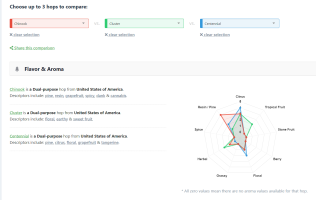Here’s my recipe for a 2.5-gallon batch of double IPA; obviously you’d want something less alcoholic and less bitter for the NE version. But the hop character is excellent:My current NEIPA keg just kicked so I need to begin recipe planning. Can anyone recommend a solid NEIPA hop schedule that I can try, that will not taste like the typical citra/galaxy batch (as all my batches taste)? I will be using Verdant IPA yeast.
RO water, Ca 140, SO4 75, Cl 200
3.6 lb. Pale Ale Malt (~2.5L)
3.6 lb. Vienna (~4L)
0.8 lb. flaked barley
0.7 lb. flaked oats (I was going to use all barley, but ran out)
0.3 lb. honey malt
OG 1.090/FG 1.010
single-infusion mash @ 148 F, 60 minutes
60-minute boil:
8 g Magnum (15.4% AA) @ 60 min.
12 g Elani/YQH-1320 (8.8% AA) @ 20 min.
10 g Nelson Sauvin (12.2% AA) @ 20 min.
10 g Cashmere LUPOMAX (13.5% AA) @ 20 min.
12 g Elani/YQH-1320 (8.8% AA) @ 5 min.
10 g Nelson Sauvin (12.2% AA) @ 5 min.
10 g Cashmere LUPOMAX (13.5% AA) @ 5 min.
12 g Elani/YQH-1320 (8.8% AA) hop stand @ 160 F for 10 min.
10 g Nelson Sauvin (12.2% AA) hop stand @ 160 F for 10 min.
10 g Cashmere LUPOMAX (13.5% AA) hop stand @ 160 F for 10 min.
24 g Elani/YQH-1320 (8.8% AA) dry hop @ packaging
20 g Nelson Sauvin (12.2% AA) dry hop @ packaging
20 g Cashmere LUPOMAX (13.5% AA) dry hop @ packaging
(I usually use a serving keg with a screened, floating dip tube. The dry hop charge is put in the keg, the keg is purged, beer is transferred in, and then the keg goes immediately into the cooler where it stays at serving temperature from that point on. I haven't had a problem with vegetal flavors developing, but I drink it quickly.)






